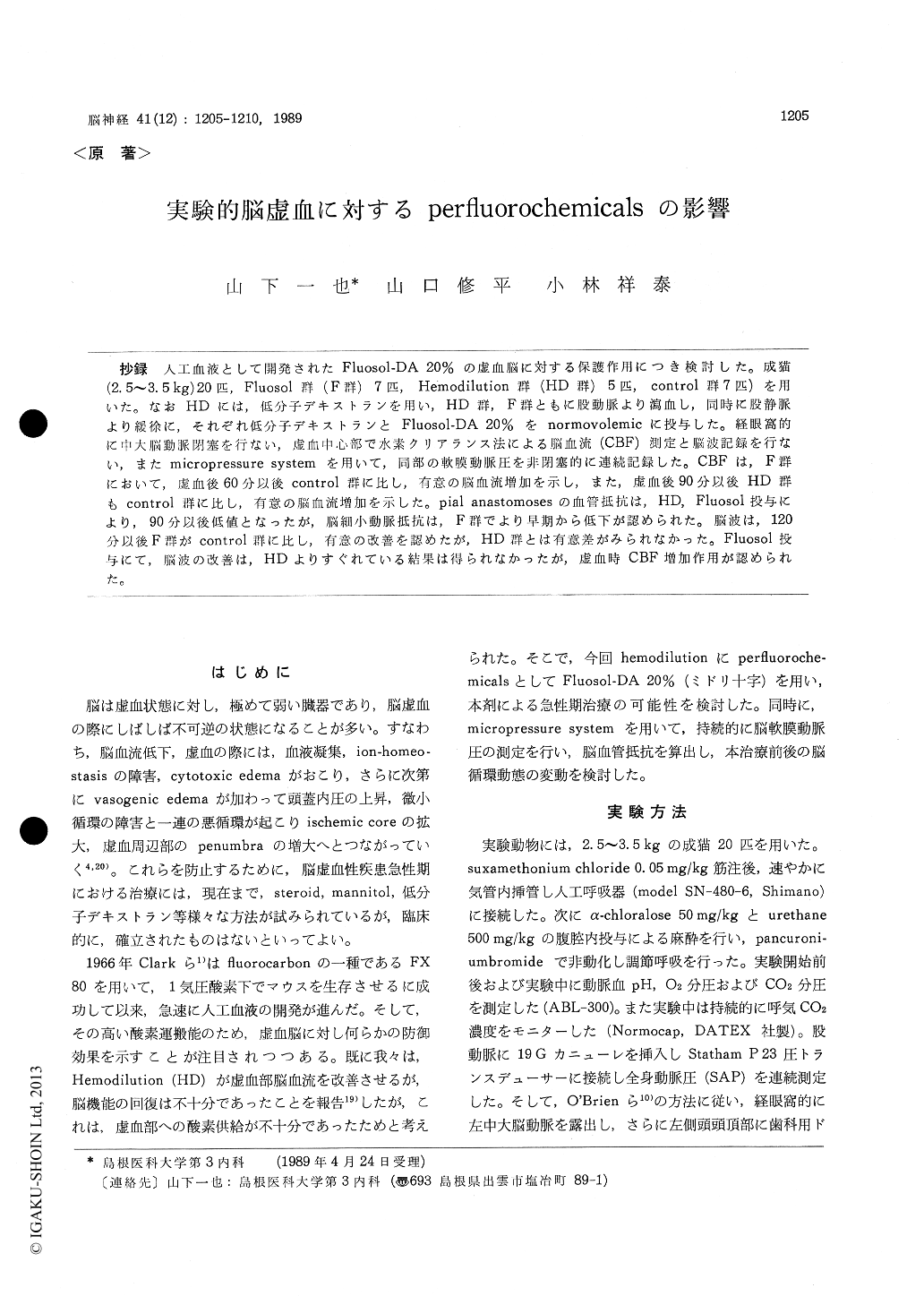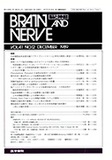Japanese
English
- 有料閲覧
- Abstract 文献概要
- 1ページ目 Look Inside
抄録 人工血液として開発されたFluosol-DA 20%の虚血脳に対する保護作用につき検討した。成猫(2.5〜3.5kg)20匹, Fluosol群(F群)7匹, Hemodilution群(HD群)5匹, control群7匹)を用いた。なおHDには,低分子デキストランを用い,HD群,F群ともに股動脈より瀉血し,同時に股静脈より緩徐に,それぞれ低分子デキストランとFluosol-DA 20%をnormovolemicに投与した。経眼窩的に中大脳動脈閉塞を行ない,虚血中心部で水素クリアランス法による脳血流(CBF)測定と脳波記録を行ない,またmicropressure systemを用いて,同部の軟膜動脈圧を非閉塞的に連続記録した。CBFは,F群において,虚血後60分以後control群に比し,有意の脳血流増加を示し,また,虚血後90分以後HD群もcontrol群に比し,有意の脳血流増加を示した。pial anastomosesの血管抵抗は,HD, Fluosol投与により,90分以後低値となったが,脳細小動脈抵抗は,F群でより早期から低下が認められた。脳波は,120分以後F群がcontrol群に比し,有意の改善を認めたが,HD群とは有意差がみられなかった。Fluosol投与にて,脳波の改善は,HDよりすぐれている結果は得られなかったが,虚血時CBF増加作用が認められた。
It has been noted that perfluorochemicals (PFC) which were developed as artificial blood substitu-tes, protect against ischemic brain injury by their ability to serve as oxygen carriers. It is also known that normovolemic hemodilution (HD) im-proves cerebral blood flow (CBF) and neurological symptoms in cerebral infarction. However, there are few reports concerning the effect of PFC on the collateral circulation via pial anastomoses in cases of middle cerebral artery (MCA) occlusion. The ability to record the pial arterial blood pres-sure (PAP) without interfering blood flow now makes it possible to measure the segmental re-sistance of cerebral vessels. By using this method, one can measure collateral vessel resistance through pial anastomoses following MCA oc-clusion. In this paper, we studied the protective effects of PFC combined with HD on ischemic brain injury with the focus on the collateral circulation via pial anastomeses following oc-clusion of the MCA. Twenty adult cats were studied : control, 8 ; HD, 5 ; Fluosol (Fluosol-DA), 7. The systemic arterial pressure (SAP) and PeCO2 were continuously monitored. Subsequently the MCA was occluded via the transorbital approach. CBF in the ectosylvian gyrus (central area of the ischemic lesion) was measured by the hydrogen clearance method. A small pial artery about 100 am in diameter on the exposed ectosylvian gyrus was punctured nonocclusively with a micropipette filled with 2 M sodium chloride which was con- nected to a servo-null micropressure system (Model 900, W-P Instruments, Inc. U. S. A.). The elec-troencephalogram (EEG) was recorded from the ectosylvian gyrus. EEG frequency was analyzed by Fast Fourier transform with a signal proces-sor (7 TO 8, Sanei) and the spectral power of the EEG was calculated by summing the Fourier coefficients covering the frequency ranging of 2-12 Hz. In the HD group, hemodilution was per-formed as follows : About 20 ml of blood was removed from the femoral artery and simulta-neously low molecular dextran was normovolemi-cally infused into the femoral vein from 10 minutes after ischemia until the hematocrit (Hct) was reduced to 24%. In the Fluosol group, Fluosol was infused normovolemically beginning 10 minu-tes after ischemia until the Hct was reduced to 25% in the same way. Data were compared using Student's t-test.
No significant differences in SAP and PAP were observed among the three groups throughout the experiment. On the other hand, the values of CBF in both the Fluosol and HD groups were signifiantly higher than in the control group at the 90-min point after MCA occlusion. Upstream resistance ((SAP-PAP)/CBF), which was conside-red as vascular resistance of the collateral circula-tion via pial anastomoses, was significantly lower in both the Fluosol and HD groups compared with the control group at the 90-min point after MCA occlusion. Furthermore, downstream resist-ance (PAP/CBF), which was also considered as vascular resistance in cerebral parenchyma, was significantly lower in the Fluosol group compared with the ccontrol group at the 30-min point after MCA occlusion. These significant differences persisted until the 180-min point. The spectral power of the EEG decreased in all groups after ischemia. Fluosol group showed a significantly greater recovery of spectrum power than the con-trol group at both the 120-min and 180-min points, but there was no significant difference between the Fluosol group and HD group after MCA occlusion.
These results suggest that PFC may improve CBF by improving collateral circulation in the ischemic lesion, but that PFC may not improve cerebral function.

Copyright © 1989, Igaku-Shoin Ltd. All rights reserved.


